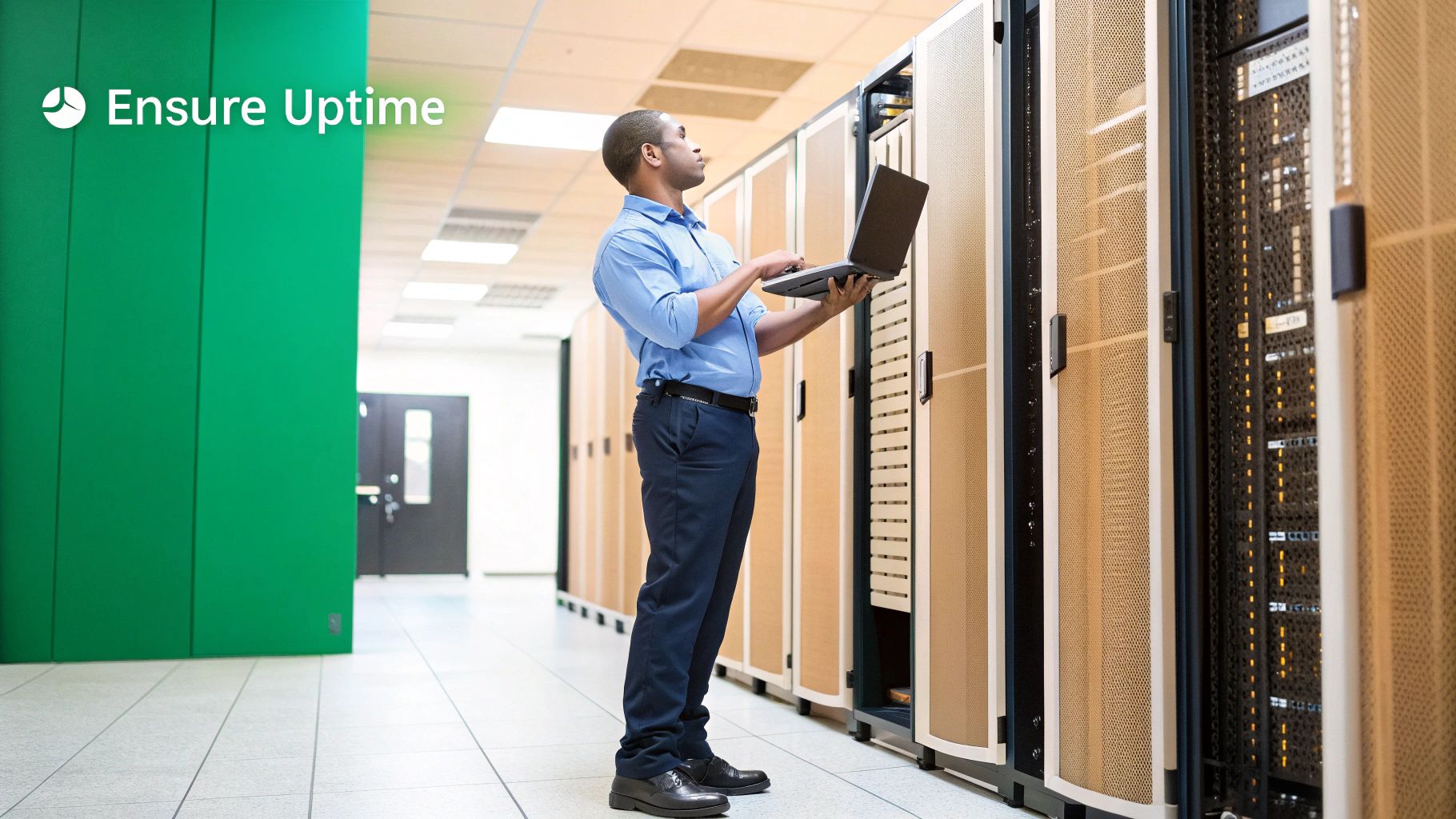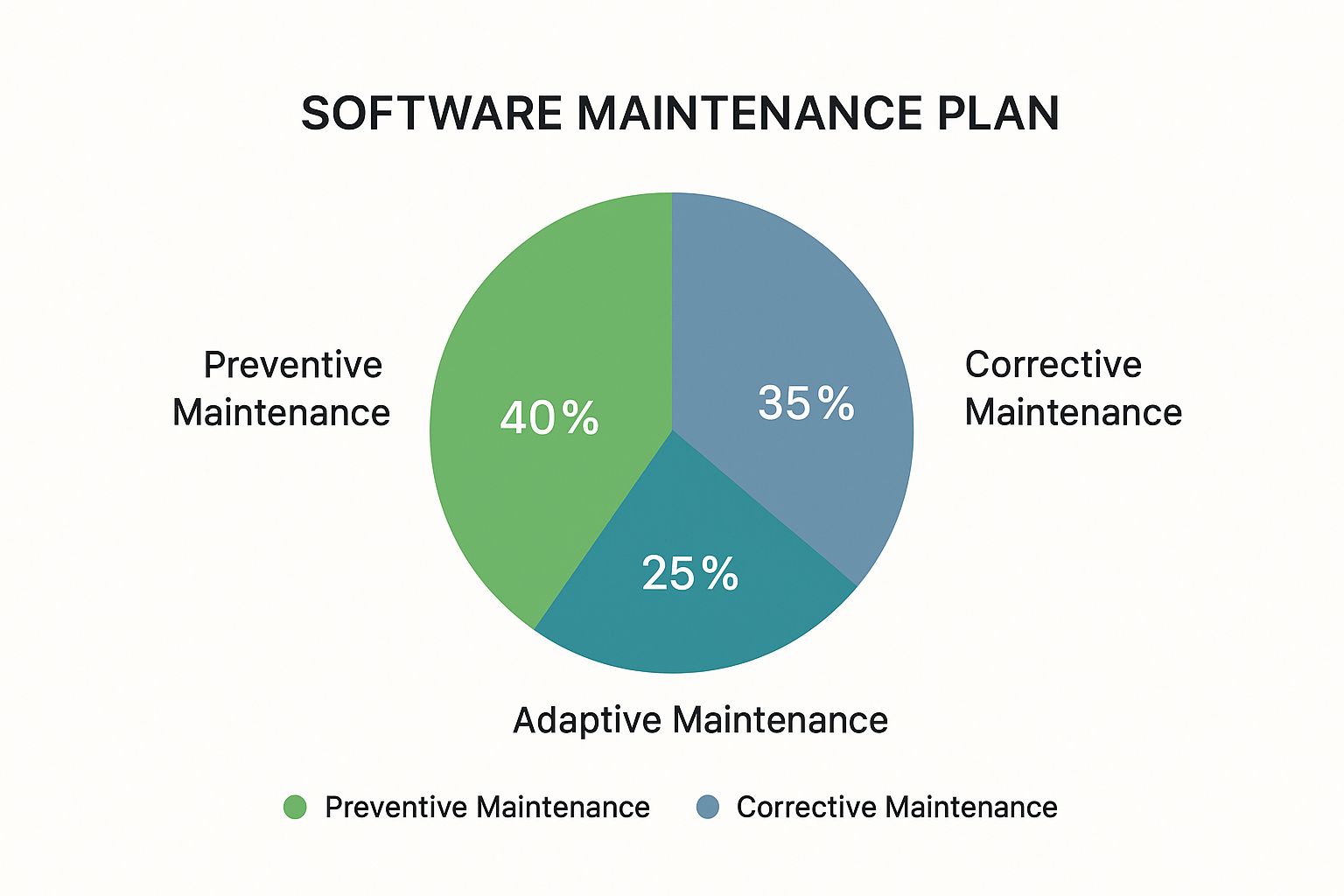Discover essential tips for creating an effective software maintenance plan to ensure system reliability and drive business growth. Learn more now!

Many businesses see software maintenance as a reactive process, only fixing things when they break. But a proactive software maintenance plan is essential for long-term success. This shift from reactive fixes to strategic planning is key for companies who want to not just survive, but thrive. It’s not just about keeping things running; it’s about optimizing performance, tightening security, and supporting business growth.
A strong software maintenance plan rests on four key pillars: corrective, adaptive, perfective, and preventive. Corrective maintenance tackles immediate issues, like bug fixes. Adaptive maintenance keeps your software compatible with changes, like new operating systems or hardware.
For instance, updating your software to work with a new web browser version is adaptive maintenance. This keeps your software functional and relevant. Perfective maintenance focuses on improving what’s already there – enhancing features and boosting performance. This could involve optimizing code or adding new features based on user feedback.
Finally, preventive maintenance is about anticipating and stopping problems before they start. Think of it like regular car maintenance. Regular oil changes prevent bigger engine issues later. These four pillars combine to create a complete and effective strategy.
A successful software maintenance plan balances immediate operational needs with long-term software sustainability. Only focusing on reactive maintenance creates a cycle of constant fixes and rising costs. But ignoring immediate issues to focus on long-term plans can also halt operations.
Successful organizations find a balance. Their software maintenance plan supports both current operations and future adaptability. This helps them manage resources wisely, prioritizing tasks based on their impact on both short-term and long-term goals.
The value of a well-defined software maintenance plan is often overlooked. Many don’t realize its potential to not only reduce costs, but also drive innovation and enhance user experience. The growth of the software maintenance market highlights its increasing importance.
The global software maintenance service market was valued at roughly USD 120 billion in 2024 and is expected to reach around USD 180 billion by 2033. This represents a compound annual growth rate (CAGR) of approximately 5.2% between 2026 and 2033. Find more detailed statistics here. A solid maintenance plan becomes a competitive edge, allowing businesses to adapt to market changes, boost customer satisfaction, and ultimately, achieve greater success. This proactive approach sets companies up to thrive in a dynamic environment.

Creating a robust software maintenance plan isn’t about following a generic template. It’s about understanding the unique needs of your organization and building a framework that aligns with your business objectives. This proactive approach goes beyond simply fixing bugs and focuses on optimizing your software’s performance to support your overall goals.
Thorough software audits are the crucial first step. These audits should go deeper than surface-level problems. They should uncover the true priorities within your software ecosystem. For example, an audit might reveal a seemingly minor feature is critical for a specific team’s workflow. This insight helps allocate resources more effectively, focusing on areas with the highest business impact.
Next, categorize your software portfolio based on its operational importance, not just its technical complexity. Identify mission-critical software versus supporting applications. Consider the potential impact of downtime for each piece of software. This categorization allows you to prioritize maintenance, ensuring essential systems receive the necessary attention.
Once you understand your software portfolio’s importance, establish realistic timelines for maintenance. This includes setting achievable deadlines for updates, upgrades, and other essential tasks. But a timeline isn’t enough. Allocate resources effectively, ensuring you have the team, budget, and tools to get the job done. This proactive planning helps prevent delays and keeps projects on track. Robust governance structures are also essential to ensure accountability and efficient decision-making.
Many organizations are adopting automation to optimize their software maintenance plans. Automated tools can handle routine tasks like testing, freeing up your team for more complex issues. For example, automated testing with tools like Selenium can catch bugs early, reducing the need for extensive manual testing later. This saves time and improves software quality. Maintain flexibility within your automated processes to handle urgent, time-sensitive updates. The software services market is rapidly growing. It was valued at approximately ****1.62 trillion by 2025, with a CAGR of 8.5%. Learn more about this growth here. This emphasizes the increasing importance of effective software maintenance. A well-structured maintenance framework ensures your software remains reliable, efficient, and aligned with your evolving business needs.
A successful software maintenance plan relies on a strong foundation. These essential elements work together, ensuring your software runs smoothly and supports your business growth. A well-structured plan addresses various aspects, from managing changes effectively to implementing robust security measures. This creates a foundation for long-term stability and the flexibility to adapt to future needs.
Building a robust software maintenance plan is like constructing a building: each element is crucial. Let’s explore the core components:
For more insights on effective documentation practices, check out this guide: How to master software documentation best practices. Thorough documentation is essential for any maintenance plan.

The infographic above illustrates the distribution of effort within a typical software maintenance plan. It highlights the balance between preventive (40%), corrective (35%), and adaptive (25%) maintenance. The emphasis on preventive maintenance underscores the importance of proactive measures to prevent issues before they occur.
The following table provides further details on the key components of a software maintenance plan:
Essential Software Maintenance Plan Components
A comprehensive breakdown of critical maintenance plan elements and their specific functions.
This table summarizes the core components of a successful maintenance strategy, emphasizing the importance of proactive measures like change management and version control alongside reactive procedures such as backups and security protocols.
Software maintenance is not just about keeping things running; it’s also about protecting your business. This involves regular backups, disaster recovery planning, and strong security protocols.
In certain industries, specialized tools like drone management software play a critical role in maintaining software that controls vital infrastructure.
Clearly defined roles and responsibilities are crucial for a successful software maintenance plan. This ensures accountability and prevents bottlenecks. Assigning ownership for specific tasks promotes responsibility and efficiency. By focusing on these components, you can create a software maintenance plan that supports both your software’s functionality and your overall business objectives.

Tired of constantly putting out fires with your software? Instead of reacting to issues as they arise, successful organizations are adopting predictive maintenance strategies. This allows them to anticipate and address problems before they disrupt operations. This proactive approach is more than just adopting new technologies; it’s a fundamental shift in how we think about system upkeep and a crucial aspect of any robust software maintenance plan.
Predictive analytics leverages data, statistical algorithms, and machine learning (Machine Learning) to forecast potential issues. By analyzing historical data, including system logs and performance metrics, it identifies patterns that suggest future problems. For instance, if specific error messages frequently precede a system crash, predictive analytics can highlight these messages as early warning signs. This empowers your team to tackle the root cause before a crash occurs, minimizing downtime and maximizing system availability.
Artificial intelligence (Artificial Intelligence) (AI) and machine learning (ML) are at the forefront of this shift toward predictive maintenance. These technologies process vast amounts of data much faster and more accurately than humans, detecting subtle anomalies that might otherwise be overlooked. This early detection gives you valuable time – potentially days or even weeks – to plan and implement maintenance strategically. Furthermore, AI and ML can optimize maintenance schedules, ensuring efficient resource allocation.
The growth of the predictive maintenance software market reflects this trend. Valued at ****23.5 billion by 2032, demonstrating the increasing integration of AI and ML into software maintenance plans. This represents a compound annual growth rate (CAGR) of approximately 15.7%. Learn more about this growing market here.
Leading organizations are pushing the boundaries of predictive maintenance by implementing automated workflows. These workflows trigger predefined actions based on specific criteria. For example, if a server’s CPU usage consistently surpasses a set threshold, an automated workflow could notify the IT team or even automatically provision additional resources.
Taking automation a step further, self-healing systems automatically diagnose and resolve minor issues without human intervention. This frees your team to focus on strategic initiatives and proactive planning, rather than constantly reacting to minor alerts. This move toward automation is a vital component of a proactive and efficient software maintenance plan. By embracing these predictive strategies, businesses can minimize downtime, reduce costs, and enhance overall software performance.
Managing software maintenance costs is crucial for long-term success. Effective cost management isn’t about cutting budgets – it’s about strategically allocating resources for maximum return on investment. This involves carefully evaluating where your maintenance budget is allocated and ensuring its effective use.
A practical budget is fundamental to any successful software maintenance plan. It should encompass both planned activities, like regular updates and security patches, and unplanned events, such as emergency bug fixes or hardware failures. A good budget anticipates both predictable and unpredictable expenses, allowing flexibility while maintaining control.
For example, allocating a portion of your budget to a contingency fund can cover unexpected costs without disrupting your overall plan. Regularly reviewing and adjusting your budget based on actual spending and changing needs keeps your financial plan aligned with operational reality. This adaptability ensures your budget remains a useful tool, not a rigid constraint.
Cost-effective vendor management is essential for controlling maintenance expenses. Negotiating favorable contracts with external service providers and evaluating their performance ensures you receive good value. This might involve comparing pricing from multiple vendors or establishing service level agreements that define performance expectations.
Strategically choosing between internal and external maintenance resources is also important. While some tasks can be efficiently handled in-house, others benefit from specialized external expertise. Complex system upgrades might be best handled by specialists, while routine maintenance can be managed internally. This balanced approach optimizes resource use and minimizes costs. You might find helpful insights in this article about managing software complexity: How to reduce technical debt.
Optimizing software licenses offers another avenue for cost savings. Many organizations find they pay for unused or consolidatable licenses. Regularly reviewing your software inventory and removing redundant licenses can significantly reduce overhead. Exploring open-source alternatives for specific software functions can also lower licensing costs. This ensures you only pay for what you use.
Using metrics to track your software maintenance plan’s effectiveness is crucial. Key performance indicators (KPIs) like mean time to repair (MTTR) and mean time between failures (MTBF) provide valuable insights into maintenance efficiency. Tracking these metrics helps identify areas for process improvement and cost reduction without compromising service quality. This data-driven approach ensures continuous improvement.
For example, a consistently high MTTR for a specific issue might suggest a need for more training or better diagnostic tools. Addressing such bottlenecks can create substantial long-term cost savings.
Finally, a successful cost management strategy must be flexible. Business priorities can change rapidly, requiring adjustments to your software maintenance plan. A flexible budget accommodates these changes while maintaining essential system stability. This may involve re-prioritizing maintenance tasks or adjusting resource allocation to align with new business goals.
To understand the different approaches and their costs and benefits, consider the following table:
Software Maintenance Cost Comparison: Analysis of different maintenance approaches and their associated costs and benefits
The table highlights the various costs and time investments associated with different maintenance types, allowing for more informed decision-making. Predictive maintenance, for instance, requires an upfront investment but can lead to long-term cost savings by preventing future issues.
This adaptable approach ensures your software maintenance plan remains a valuable asset, supporting your organization’s evolving needs. By implementing these cost management strategies, businesses can ensure their software investments contribute to long-term success. This proactive approach maximizes software value while minimizing unnecessary expenses.
Implementing a software maintenance plan successfully requires more than just a well-written document. It takes careful execution and a clear understanding of potential pitfalls. A proactive and strategic approach is essential, focusing on both the technical implementation and engaging with stakeholders. This means fostering genuine buy-in from everyone involved, not simply achieving reluctant compliance.
Engaging stakeholders early and often is crucial for a smooth implementation. This involves clearly communicating the plan’s goals, benefits, and expected outcomes to everyone affected, from end-users to executive leadership. This transparency fosters understanding and encourages collaboration.
Actively soliciting feedback and addressing concerns throughout the process helps build a sense of ownership and increases the likelihood of successful adoption. Regular meetings to update stakeholders on progress and answer any questions can significantly improve engagement.
Additionally, establishing clear communication channels for reporting issues and providing feedback ensures smooth collaboration. These strategies build trust and promote shared responsibility for the plan’s success.
Implementation inevitably encounters challenges. Resource constraints, competing priorities, and resistance to change are common obstacles. Proactively addressing these challenges is critical for the plan’s long-term success.
Clearly outlining resource allocation in the initial planning stages can mitigate potential resource conflicts. Prioritizing tasks based on business impact ensures focus remains on the most critical aspects of the plan.
Addressing resistance to change requires understanding the root causes of the resistance. Open communication and demonstrating the plan’s benefits with tangible examples can help alleviate concerns and foster acceptance. A flexible and adaptable implementation approach is key to navigating these common challenges.
Defining clear metrics for measuring success is vital for demonstrating the value of your software maintenance plan. These metrics should align with overall business goals and track progress toward specific objectives.
Metrics like reduced downtime, lower maintenance costs, and improved system performance provide quantifiable evidence of the plan’s effectiveness. For example, tracking the number of unplanned outages before and after implementation can showcase a reduction in downtime.
Similarly, monitoring maintenance costs over time can reveal savings achieved through proactive maintenance. Regularly monitoring and reporting on these metrics demonstrates value to leadership and justifies continued investment.
A truly successful software maintenance plan goes beyond a one-time implementation; it creates a sustainable maintenance culture. This means embedding maintenance best practices into daily workflows and fostering a proactive mindset toward system upkeep.
Regular training programs can educate teams on the importance of maintenance and equip them with the necessary skills. Establishing clear roles and responsibilities ensures accountability and promotes a sense of ownership.
Building feedback loops for continuous improvement ensures the plan adapts to evolving business needs. This creates a self-sustaining system where maintenance is viewed as a vital contributor to organizational success, not a burden.